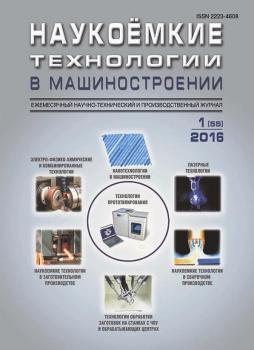Tula, Russian Federation
Russian Federation
621.983.3
539.376
The operation of obtaining cylindrical products with a titling pad made of titanium alloy VT6 is viewed in the article. The operation involves impacting a bar blank made of titanium alloy VT6 with the use of a punch having sloped edge. When obtaining parts having titling pad made of difficult-to-form alloys, it is necessary to formulate the modes of technology. It is required to specify the rates of deformation and the impact of contact friction on the kinematics of the material flow and the force of shape change to assess the capabilities of the process performed by CAE modeling. Therefore, the simulation of obtaining cylindrical products with a titling pad made of titanium alloy VT6 was performed in the DEFORM modeling program. The influence of the speed conditions of the operation on the change in the values of stress intensities in the product was found. The dependences of the influence of the angles and rates of deformation on the landing force are revealed. The results of theoretical studies obtained during the simulation were summarized. A regression analysis of the results obtained during the simulation was performed. Based on the simulation results, expressions for estimating the intensity of stresses are obtained. The results of regression modeling are in good agreement with the results of computer modeling. Using quantitative modeling results, a regression assessment of the force was taken. Regression equations in natural values are obtained for the assessment of the impact of key process parameters during setup, which can be useful directly when assigning technological modes of titanium alloy blanks setup. The results can be used in the implementation of manufacturing technologies for parts with flange seals, characterized by the best strength characteristics and good load resistance.
setup, research, change of shape, modeling
Сплошные цилиндрические детали с фланцем распространены в машиностроении. Технологии их получения достаточно отработаны [1 – 4]. В основном их получают высадкой. Но при получении деталей с наклонным фланцем из труднодеформируемых сплавов необходимо уточнение режимов технологии изготовления [5 – 8]. Требуется уточнение скоростей деформирования и воздействия контактного трения на кинематику течения материала и силы формоизменения [9 – 12]. Весьма удобным инструментом для этого является моделирование данного процесса в CAE-комплексе [13 – 15]. Поэтому выполнено моделирования операции получения цилиндрических изделий с наклонным фланцем из титанового сплава ВТ6. Выявлено влияние угла скоса пуансона, контактного трения и скоростей формоизменения на силы высадки и кинематику течения материала заготовки.
Исследована осадка прутка диаметром 60 мм. Схема процесса представлена на рис. 1. При расчетах считаем, что свободная часть заготовки имеет высоту , равную двум диаметрам
. Влияние скорости деформирования исследовалось в интервале 1,0…200 мм/мин. Материал заготовки – сплав ВТ6. Процесс рассчитывался при температуре деформирования 900 ℃. Угол конусности пуансона α = 0…7,0 ̊. Ход инструмента рассматривался в интервале
Схемы процесса высадки на конечном этапе при наибольшей величине силы для разных значений угла и с разными скоростями деформирования представлены на рис. 2 – 4. Данные схемы иллюстрируют изменение интенсивностей напряжений для варьируемых параметров.
Установлено, что на изменение интенсивностей напряжений в объеме детали наибольшее влияние оказывает изменение скоростных режимов операции. Рост скоростей деформирования приводит к увеличению значений интенсивностей напряжений в два раза. Увеличение угла скоса пуансона ведет к росту интенсивностей напряжений на 20…25 %.
Выявленные зависимости влияния углов и скоростей деформирования на силу процесса высадки приведены на рис. 5 и рис. 6.
Изменённые силы высадки в зависимости от скоростей деформирования и угла конусности носит характер похожий на изменение интенсивностей напряжений. Рост скорости перемещения инструмента в интервале 3…200 мм/мин может приводить к увеличению силовой нагрузки в четыре раза для пуансонов с большими углами конусности и в пять раз для пуансонов с меньшими углами конусности. Рост угла конуса пуансона ведет к снижению силы на 50 %. Разница в величинах углов конусности становится заметной в конце рабочего хода инструмента.
Результаты теоретических исследований, полученных в ходе моделирования, были обобщены. А именно был выполнен регрессионный анализ полученных в ходе моделирования результатов. В качестве входных параметров были приняты скорость деформирования , угол пуансона
и коэффициент трения
. Данные для регрессионного моделирования приведены в табл. 1. Матрица планирования представлена в табл. 2 [12].
По результатам моделирования получены выражения для оценки интенсивности напряжений в кодированных и натуральных величинах:
Результаты регрессионного моделирования хорошо согласуются с результатами компьютерного моделирования. Наибольшее влияние на силовые режимы оказывает скорость деформирования. Таким образом, при необходимости формирования скоса на заготовке с углами более 3,0 ̊ обеспечение скоростных условий в интервале 3,0…30 мм/мин позволяет обеспечить снижение силовой нагрузки и снижению неравномерности напряженного состояния. Полученные результаты можно использовать при разработке технологий высадки изделий со скошенным фланцем как рекомендации для назначения режимов деформирования.
1. Demin V. A., Larin S. N., Riskin R. V., Rizkova A. A. Stu0y the influence of anisotropy of the drawing cylindrical part // CIS Iron and Steel Review / Vol. 16 (2018), pp. 25-28 DOI: https://doi.org/10.17580/cisisr.2018.02.05; EDN: https://elibrary.ru/TUECEV
2. Larin S.N., Platonov V.I., Larina M.V. Influence of the geometry of the deforming tool on the stress-strain state during combined extrusion //Bulletin of the Tula State University. Technical sciences, 2020, No, 5. pp. 451-456 EDN: https://elibrary.ru/ECSYBY
3. Zhichao Sun, Jing Cao, Huili Wu, Zhikun Yin. Inhomogeneous deformation law in forming of multi-cavity parts under complex loading path // Journal of Materials Pro-cessing Technology. 2018. Vol. 254. P. 179-192. DOI: https://doi.org/10.1016/j.jmatprotec.2017.11.019; EDN: https://elibrary.ru/ZGSXZM
4. Springer P, Prahl U Characterisation of mechanical behavior of 18CrNiMo7-6 steel with and without under warm forging conditions through processing maps analysis // Journal of Materials Processing Technology, 2016. Vol.237. P. 216-234.
5. Demin V.A., Larin S.N. Technological support and improvement of the quality of blanks obtained by metal pressure treatment// Science-intensive technologies in mechanical engineering, 2022, No. 8 (134), pp. 12-19. DOI: https://doi.org/10.30987/2223-4608-2022-8-12-19; EDN: https://elibrary.ru/PHBTDS
6. Aksenov S.A., Chumachenko E.N, Kolesnikov A.V, Osipov S.A. Determination of optimal gas forming conditions from free bulging tests at constant pressure Journal of Materials Processing Technology. 2015. Vol. 217. P. 158-164.
7. Larin S.N., Pasynkov A.A., Nuzhdin G.A. Reverse extrusion of a rod blank with active friction and extrusion of thickening at the end // Science intensive technologies in mechanical engineering, 2020, No. 6 (108), pp. 16-20. DOI: https://doi.org/10.30987/2223-4608-2020-6-16-20; EDN: https://elibrary.ru/IUBSEK
8. Malinin N.N. Creep in metal processing. Moscow: Mashinostroenie, 1986. 216 p. EDN: https://elibrary.ru/XXLGDN
9. Pasynkov A.A., Boriskin O.I., Larin S.N. Teoreticheskie issledovaniya operacii izotermicheskoy razdachi trub iz trudnodeformiruemyh cvetnyh spavov v usloviyah kratkovremennoy polzuchesti // Cvetnye metally. 2018. № 2. S. 74-78.
10. Larin S.N., Pasynkov A.A. Analysis of forming properties during the isothermal upsetting of cylindrical workpieces in the viscous-plasticity mode // IOP Conference Series: Materials Science and Engineering. Vol. 441. Issue 1, 2. November 2018.
11. Theory of plastic deformations of metals / E. P. Unksov, W. Johnson, V. L. Kolmogorov et al. Moscow: Mashinostroenie, 1983, 598 p.
12. Panfilov G.V., Nedoshivin S.V., Perminov D.A. Application of statistical machine experiment for investigating theoretical models stamping cores bullets. Izvestiya Tula State University: Technical Sciences Series. 2014, No. 6, pp. 61-73. EDN: https://elibrary.ru/STYCMJ
13. Chernyaev A.V., Charin A.V., Gladkov V.A. Study of power modes of the radial extrusion of internal thicknesses on pipe works. Izvestiya Tula State University: Technical Sciences Series. 2014, No.10, pp. 440-445. EDN: https://elibrary.ru/PHPPAN
14. Theory of metal pressure forming: college textbook / V.A. Golenkov, S.P. Yakovlev, S.A. Golovin, S.S. Yakovlev, V.D. Kukhar / Edited by V.A. Golenkov, S.P. Yakovlev. Moscow: Mashinostroenie, 2009. 442 p. EDN: https://elibrary.ru/QNCKVH
15. Pasynkov A.A., Larin S.N., Isaeva A.N. Theoretical studies of the operation of isothermal expansion of pipes from difficult-to-form non-ferrous alloys in conditions of short-term creep. / Blank production in machine-building, 2020, No. 10, pp. 462-465 EDN: https://elibrary.ru/CJWHEJ

















